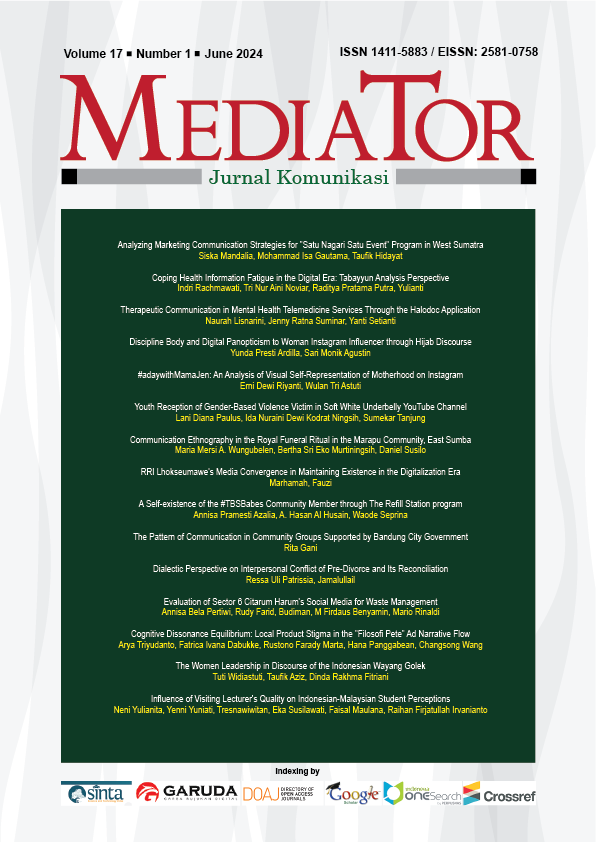Dialectic Perspective on Interpersonal Conflict of Pre-Divorce and Its Reconciliation
DOI:
https://doi.org/10.29313/mediator.v17i1.3505Keywords:
communication conflict, marriage couples, marriage communication, predivorced, interpersonal communicationAbstract
This research examines the Dialectic Perspective of Interpersonal Conflict of Pre-Divorce and Its Reconciliation. The development of the divorce rate in Indonesia has reached its peak in 2022 compared to the last six years. These phenomena interest the researcher in discovering how the married couple in dispute can resolve their marriage and repair their relationship. This research is based on the theory of relational dialectics as a ground theory, supported by narrative sense-making as the middle theory, and complemented by dialogic listening theory as the applied theory for supporting conflict resolution. The method used was a qualitative descriptive approach to study the case of four informants with criteria determined by the researcher. The results of this study indicate a framework dimension from the precursor of marriage conflict, namely individual character and family character, forward to the process of the conflict where the dimension of interpersonal conflict and addressing or problem-solving of the conflict is found, to the reconciliation dimension that contributes to the success of reconciliation such as time, agreement, use of future narrative, satisfaction, financial performance, habitual interdependence, and religion and cultural constraints.
References
AJ, O. (2018). Patterns And Causes Of Marıtal Conflıct Among Staff Of Selected Unıversıtıes In Southwest Nıgerıa. Advances in Social Sciences Research Journal, 5(8), 306–320.
Altman, E. I. (1993a). Corporate Financial Distress and Bankruptcy (2nd ed.). John Wiley & Sons.
Altman, E. I. (1993b). Corporate Financial Distress and Bankruptcy. (2nd ed.). John Wiley & Sons.
Anderson, K., Kondili, E., Stiller, C., Korenchuk, J., & Jennings, S. E. (2023). Personal Barriers to High Conflict Domestic Dispute Resolution. Family Journal. https://doi.org/10.1177/10664807231202418
Anderson, S. A., Sabatelli, R. M., & Kosutic, I. (2007). Families, Urban Neighborhood Youth Centers, and Peers as Contexts for Development. Family Relations, 56(4), 346–357. https://doi.org/10.1111/j.1741-3729.2007.00464.x
Barki, & Hartwick. (2002). Conceptualizing the Construct of Interpersonal Conflict. International Journal of Conflict Management, 15(3), 216–244. https://doi.org/10.1108/eb022913
Baxter, L. A., & Braithwaite, D. O. (2008). Relational dialectics theory: Crafting meaning from competing discourses. In L. A. Baxter & D. O. Braithwaite (Eds.), Engaging theories in interpersonal communication. Sage.
Baxter, L. A., & Montgomery, B. M. (1996). Relating: Dialogues and dialectics. Guilford Press.
Bell, D. C., Chafetz, J. S., & Horn, L. H. (1982). Marital conflict resolution: A study of strategies and outcomes. Journal of Family Issues, 3, 111–132.
Biro Pusat Statistik. (2020). Tinjauan Big Data Terhadap Dampak Covid-19 2020. Biro Pusat Statistik.
Blake, R., & Mouton, J. (1964). The Managerial Grid: The Key to Leadership Excellence. Gulf Publishing Company.
Boardman, S. K., & Horowitz, S. V. (1994). Constructive conflict management and social problems: An introduction. Journal of Social Issues, 50, 1–12.
Brown, P., & Levinson, S. C. (1987). Politeness: Some universals in language usage. Cambridge University Press.
Bungin, B. (2011). Metodologi Penelitian Kualitatif. Rajawali Press.
Caughlin, J. P., & Gerlikovski, E. (2023). Conflict in Family Communication. In Oxford Research Encyclopedia of Communication. Oxford University Press. https://doi.org/10.1093/acrefore/9780190228613.013.1465
Christensen, A., & Heavey, C. L. (1990). Gender and social structure in the demand/withdraw pattern of marital conflict. Journal of Personality and Social Psychology, 59(1), 73–81. https://doi.org/10.1037/0022-3514.59.1.73
Cunliffe, A. L. (2011). Crafting Qualitative Research. Organizational Research Methods, 14(4), 647–673. https://doi.org/10.1177/1094428110373658
Curun, F. (2006). Yüklemeler, iletişim çatışmaları, cinsiyet ve cinsiyet rolü yönelimi ile evlilik doyumu arasındaki ilişki. Ankara University.
Davletova, N. (2021). Wedding and Marriages. Интернаука, 21(4), 81–83.
Deutsch, M. (1973). The Resolution of Conflict. American Behavioral Scientist, 17(2), 248–248. https://doi.org/10.1177/000276427301700206
Eldridge, K. A., & Christensen, A. (2002). Demand-Withdraw Communication during Couple Conflict: A Review and Analysis. In Understanding Marriage (pp. 289–322). Cambridge University Press. https://doi.org/10.1017/CBO9780511500077.016
Emeng, G. I., & Eteng, N. G. (2022). Divorce: An Unending Phenomenon in Human Society. In HUMAN: South Asean Journal of Social Studies (Vol. 2, Issue 2).
Gandy, O. H., & Gandy Jr, O. H. (2021). The panoptic sort: A political economy of personal information. Oxford University Press (OUP).
Gehrke, P. J. (2009). Introduction to Listening, Ethics, and Dialogue: Between the Ear and the Eye: A Synaesthetic Introduction to Listening Ethics. International Journal of Listening, 23(1), 1–6. https://doi.org/10.1080/10904010802631023
Gottman, J. M., & Krokoff, L. J. (1989). Marital interaction and satisfaction: A longitudinal view. Journal of Consulting and Clinical Psychology, 57(1), 47–52. https://doi.org/10.1037/0022-006X.57.1.47
Greeff, P., & De Bruyne, T. (2000). Conflict management style and marital satisfaction. Journal of Sex & Marital Therapy, 26, 321–334.
Heavey, C. L., Layne, C., & Christensen, A. (1993). Gender and conflict structure in marital interaction: A replication and extension. Journal of Consulting and Clinical Psychology, 61(1), 16–27. https://doi.org/10.1037/0022-006X.61.1.16
Heider, F. (1958). The psychology of interpersonal relations. John Wiley & Sons Inc.
Hidayat, D., Rohendi, A., Hanafy D, D., Christin, M., & Nur’aeni, N. (2022). FIGHTING THE DISINFODEMIC: FACT- CHECKING MANAGEMENT OF HOAX COVID-19 IN INDONESIA. Profetik: Jurnal Komunikasi, 15(2), 272. https://doi.org/10.14421/pjk.v15i2.1996
Hodgetts, D. J., & Stolte, O. E. E. (2012). Case‐based Research in Community and Social Psychology: Introduction to the Special Issue. Journal of Community & Applied Social Psychology, 22(5), 379–389. https://doi.org/10.1002/casp.2124
Holmberg, D., Orbuch, T., & Veroff, J. (2004). Thrice-told tales: Married couples tell their stories. Erlbaum.
Johnson, D. W., & Johnson, R. T. (1994). Learning Together and Alone. Cooperative, Competitive, and Individualistic Learning. Allyn and Bacon.
Kamp Dush, C. M., & Taylor, M. G. (2012). Trajectories of Marital Conflict Across the Life Course. Journal of Family Issues, 33(3), 341–368. https://doi.org/10.1177/0192513X11409684
Klinetob, N. A., & Smith, D. A. (1996). Demand-Withdraw Communication in Marital Interaction: Tests of Interspousal Contingency and Gender Role Hypotheses. Journal of Marriage and the Family, 58(4), 945. https://doi.org/10.2307/353982
Knapp, M., Stohl, C., & Reardon, K. (2006). “Memorable” Messages. Journal of Communication, 31, 27–41. https://doi.org/10.1111/j.1460-2466.1981.tb00448.x
Koenig Kellas J., Willer E. W., & Trees A. R. (2013). Communicated perspective-taking during stories of marital stress: Spouses’ perceptions of one another’s perspective-taking behaviors. Southern Communication Journal, 78(4), 326–351.
Littlejohn, S., Foss, K. A., & Oetzel, J. G. (2021). Theories of Human Communication (12th ed.). Waveland Press.
Lyman, S. M., & Scott, M. B. (1967). Territoriality: A neglected sociological dimension. Social Problems, 15(2), 236–249.
Manusov, V., & Spitzberg, B. (2008). Attribution theory. In L. A. Baxter & D. O. Braithewaite (Eds.), Engaging theories in interpersonal communication: Multiple perspectives (pp. 37–49). Sage Publications, Inc.
Marchand. (2004). Husbands’ and wives’ marital quality: the role of adult attachment orientations, depressive symptoms, and conflict resolution behaviors. Attachment & Human Development, 6(1), 99–112.
McAdams, D. P. (1993). The stories we live by: Personal myths and the making of the self. William Morrow & Co.
McNulty, J. K., & Russell, V. M. (2010). When “negative” behaviors are positive: A contextual analysis of the long-term effects of problem-solving behaviors on changes in relationship satisfaction. Journal of Personality and Social Psychology, 98(4), 587–604. https://doi.org/10.1037/a0017479
Omeje, L. N. (2014). Dominance educational level and child-sex as predictors of marital conflict [Unpublished Masters of Science Degree submitted to the Department of Psychology, Faculty of Social Science]. University of Nigeria.
Rahim, M. A. (2000). Empirical studies on managing conflict. The International Journal of Conflict Management, 11, 5–8.
Rawlins, W. K. (1992). Friendship matters: Communication, dialectics, and the life course. Aldine de Gruyter.
Sabourin, T. C. (2003). The Contemporary American Family: A Dialectical Perspective on Communication and Relationships. https://doi.org/10.4135/9781452232430
Scheeren, P., Pfrang, H., & Rausche, A. (1983). Marital quality and attachment: the mediator role of conflict resolution styles. Archives of Sexual Behavior, 12(1), 31–42.
Sheth, J. N. (1973). A Model of Industrial Buyer Behavior. Journal of Marketing, 37(4), 50. https://doi.org/10.2307/1250358
Shotter J. (2009). Listening in aWaythat recognizes/realizes the world of “the other.” International Journal of Listening, 23(1).
Sillars, A., & Canary, D. J. (2013). Conflict and Relational Quality in Families. In A. L. Vangelisti (Ed.), Routledge handbook of family communication (pp. 338–357). Routledge.
Singh, A. K., & Singh, P. K. (2019). Recent trends, current research in cyberpsychology: A literature review. Library Philosophy and Practice, 2019.
Soylu, Y., & Kağnıcı, D. Y. (2015). Evlilik uyumunun empatik eğilim, iletişim ve çatışma çözme stillerine göre yordanması. Türk Psikolojik Danışma ve Rehberlik Dergisi, 5, 44–54.
Taylor, S. E., Peplau, L. A., & Sears, D. O. (2015). Psikologi Sosial. Kencana.
Thomas, K. W., & Kilman, R. H. (1974). Thomas-Kilmann Conflict Mode Instrument. Consulting Psychologists Press.
Thomas, K. W., & Schmidt, W. H. (1976). A survey of managerial interests with respect to conflict. Acad Manage, 19, 315–318.
Tolorunkele, C. A. (2014). Causes of Marital Conflicts Amongst Couples in Nigeria: Implication for Counselling Psychologists. Procedia - Social and Behavioral Sciences, 21–26.
Turner, L. H., & West, R. (2014). The SAGE handbook of family communication. In The SAGE Handbook of Family Communication. https://doi.org/10.4135/9781483375366
Uğurlu, O. (2003). Evli çiftlerde cinsiyet ayrımına ilişkin tutumlar, çatışma yönetimi biçimleri ve evlilik uyumu arasındaki ilişki. In Yüksek Lisans Tezi Ankara University. Ankara University.
Ünal, Ö., & Akgün, S. (2022). Relationship of conflict resolution styles in marriage with marital adjustment and satisfaction. Psikiyatride Güncel Yaklaşımlar, 14, 322–330.
van de Vliert, E., & Euwema, M. C. (1994). Agreeableness and activeness as components of conflict behaviors. Journal of Personality and Social Psychology, 66, 674–687.
Vuchinich, S. (1987). Starting and stopping spontaneous family conflicts. Journal of Marriage Family, 591–601.
Wilson, S. R. (2007). Communication Theory and the Concept of "Goal. In Explaining communication: Contemporary theories and exemplars (pp. 73–104). Lawrence Erlbaum Associates Publishers.
Wilson, S. R., & Sabee, C. M. (2003). Explicating communicative competence as a theoretical term. In J. O. Greene & B. R. Burleson (Eds.), Handbook of communication and social interaction skills (pp. 3–50). Lawrence Erlbaum Associates Publishers.
Downloads
Published
Issue
Section
License
Copyright (c) 2024 Ressa Uli Patrissia, Jamalullail

This work is licensed under a Creative Commons Attribution-ShareAlike 4.0 International License.























